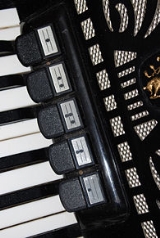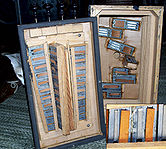
Accordion reed ranks & switches
Encyclopedia


Reed (instrument)
A reed is a thin strip of material which vibrates to produce a sound on a musical instrument. The reeds of most Woodwind instruments are made from Arundo donax or synthetic material; tuned reeds are made of metal or synthetics.-Single reeds:Single reeds are used on the mouthpieces of clarinets...
that are the means to achieve the instrument's sound range. These reed ranks are located in the reed chamber. Most accordions to this date typically have anywhere between 2-4 reed ranks on the treble side and 3-5 reed ranks on the bass side that can usually be selected individually and/or be combined differently to provide a range of different timbre
Timbre
In music, timbre is the quality of a musical note or sound or tone that distinguishes different types of sound production, such as voices and musical instruments, such as string instruments, wind instruments, and percussion instruments. The physical characteristics of sound that determine the...
s, by use of switches arranged by register
Register (music)
In music, a register is the relative "height" or range of a note, set of pitches or pitch classes, melody, part, instrument or group of instruments...
from high to low. More of the top-line expensive accordions may contain 5-6 reed blocks on the treble side for different tunings
Musical tuning
In music, there are two common meanings for tuning:* Tuning practice, the act of tuning an instrument or voice.* Tuning systems, the various systems of pitches used to tune an instrument, and their theoretical bases.-Tuning practice:...
, typically found in accordions which stress musette sounds.
How many reeds an accordion has is defined by a method that looks like a fraction. For example, a 4/5 accordion has 4 reeds on the treble side and 5 on the bass side. A 3/4 accordion has 3 reeds on the treble sides and 4 on the bass side.
Reed ranks are classified by either organ 'foot-length' stops or instrument names. Visually, they each have a fixed dot in a three-level icon as displayed in the photo on the right and tables below. These icons display when more than one reed-rank is in use.
Register stop classifications
The pitch of a single bank of reeds is traditionally defined in a similar manner to the organ stops of a pipe organPipe organ
The pipe organ is a musical instrument that produces sound by driving pressurized air through pipes selected via a keyboard. Because each organ pipe produces a single pitch, the pipes are provided in sets called ranks, each of which has a common timbre and volume throughout the keyboard compass...
. A bank that sounds at unison pitch
Unison
In music, the word unison can be applied in more than one way. In general terms, it may refer to two notes sounding the same pitch, often but not always at the same time; or to the same musical voice being sounded by several voices or instruments together, either at the same pitch or at a distance...
when keys are depressed is called 8'; pitch: alluding to the length of the lowest-sounding organ pipe in that rank, which is approximately eight feet. For the same reason, a stop that sounds an octave higher is at 4' pitch, and one that sounds an octave lower than unison pitch is at 16' pitch.
Most reed registers are normally in relative octave
Octave
In music, an octave is the interval between one musical pitch and another with half or double its frequency. The octave relationship is a natural phenomenon that has been referred to as the "basic miracle of music", the use of which is "common in most musical systems"...
tuning, but rarely, some instruments have a reed bank tuned to a Fifth relative to the 8' stop (or some octave of that). This is a similar arrangement to stops for a pipe organ
Pipe organ
The pipe organ is a musical instrument that produces sound by driving pressurized air through pipes selected via a keyboard. Because each organ pipe produces a single pitch, the pipes are provided in sets called ranks, each of which has a common timbre and volume throughout the keyboard compass...
.
| Icon | Classification | Description |
|---|---|---|
 |
4' stop | This is the highest reed rank. Not all accordions will have this reed rank. |
 |
8' stop | This is the basic middle reed rank. It is one octave lower than a 4' reed rank. |
 |
8' stop | This is another middle reed rank, the upper tremolo rank. It is usually tuned slightly higher than the basic middle reed rank. Not all accordions may have this reed rank. |
 |
8' stop | This is another middle reed rank, the lower tremolo rank. It is usually tuned slightly lower than the basic middle reed rank. Usually only included on special "musette accordions". |
 |
16' stop | This is the lowest and deepest-sounding reed rank in the reed chamber. It is one octave lower than an 8' reed rank. |
To hear how these sound on their own, see the first three rows of the table below.
Register switches
RegisterRegister (music)
In music, a register is the relative "height" or range of a note, set of pitches or pitch classes, melody, part, instrument or group of instruments...
switches control how contrasting timbre
Timbre
In music, timbre is the quality of a musical note or sound or tone that distinguishes different types of sound production, such as voices and musical instruments, such as string instruments, wind instruments, and percussion instruments. The physical characteristics of sound that determine the...
s are produced. They control which reed ranks are enabled (opened up) or disabled (closed off), in a similar manner to the register switches controlling the organ stops of a pipe organ
Pipe organ
The pipe organ is a musical instrument that produces sound by driving pressurized air through pipes selected via a keyboard. Because each organ pipe produces a single pitch, the pipes are provided in sets called ranks, each of which has a common timbre and volume throughout the keyboard compass...
: a single reed rank, or several simultaneous reed ranks. Unlike a pipe organ, only one switch can be active at any given time. Here are a few examples of right-hand manual switches on a typical large accordionTable made with reference from this article at NewMusicbox (Smaller boxes with fewer reed banks may have fewer switches or even none):
| Icon | Nickname | Register stop(s) in use | Sound |
|---|---|---|---|
 |
Piccolo | 4' | Thin and reedy tone. Listen here (MP3) |
 |
Clarinet | 8' | A round tone, pure and free of harmonics. Listen here (MP3) |
 |
Bassoon | 16' | A full, smooth tone. Listen here (MP3) |
 |
Oboe | 4'+8' | A thin tone Listen here (MP3) |
 |
Violin | 8'+8' | Listen here: Dry-tuned (MP3), Wet-tuned (MP3) |
 |
Musette (Imitation) | 4'+8'+8' | Actually an imitation musette sound. Found in most accordions. See the last entry in this table. Listen here (MP3) |
 |
Musette (Authentic) | 8'+8'+8' | A strong and distinctive sound, built for special "Musette accordions". Tremolo. Listen here (MP3) |
 |
Organtype (Organ) | 4'+16' | A slightly reedy quality. Listen here (MP3) |
 |
Harmonium | 4'+8'+16' | Like the Oboe stop, but heavier because of the added 16' reed rank. Listen here (MP3) |
 |
Bandoneón | 8'+16' | Characteristic round, mellow accordion sound. Listen here (MP3) |
 |
Accordion | 8'+8'+16' | Like the Violin stop, but heavier because of the added 16' reed rank. Listen here (MP3) |
 |
Master | 4'+8'+8'+16' | The loudest and fullest accordion sound. Listen here (MP3) |
In addition to the master switch located with the other switches shown above, professional grade accordions often have a least one extra master switch: either a chin master at the top of the instrument or palm master switch located at the side of the keyboard. These are located in positions that allow for faster changes to the full sound during playing.
Cassotto
More expensive accordions have a feature called a Cassotto (Italian for "box"), also referred to as a "tone chamber", in the treble (right-hand) reed section. In this design, certain reed sets (usually one set of middle reeds, and the set of low reeds) are mounted at a 90-degree angle to the remaining reeds. The sound from these specially-mounted reeds must then travel farther, and along a different path, before leaving the instrument, muting the harmonics (partials) of those reeds and creating a distinctively mellow, refined sound. The sound of cassotto bassoon (low) reeds is particularly favored by jazz accordionists.The cassotto design requires a sophisticated treble mechanism where each key must open and close air passages not only for reeds mounted at the traditional angle, but also for air passages at a relative 45-degree angle (for the cassotto reeds). To do this properly, each rod and pad must be positioned precisely in relation to its right-angle counterpart.

